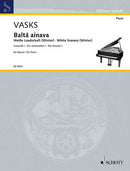| 作曲者 | Peteris Vasks (b. 1946)・ヴァスクス |
| タイトル | Balta ainava (piano) |
| サブタイトル | (White Scenery (Winter)) |
| 出版社 | Schott・ショット |
| 楽器編成 | piano |
| 品番 | 9790001082846 |
| 難易度 | 中級 |
| 形状 | 12 ページ・中綴じ |
| 演奏時間 | 7分 |
| 作曲年 | 1980年 |
| 出版年 | 2012年 |
| 出版番号 | ED 8047 |
| ISMN | 9790001082846 |
Peteris Vasks occupies a special position in the circle of Baltic composers. He is not only the most significant and popular composer ever to come out of Latvia, he always speaks to his listeners with a fervent intensity that seems to point to something higher. This higher aspect is without a doubt something that stands above the world of humanity but is also present within each person: divine nature. “I am deeply rooted in nature, in the nature of the North. It influences all of my music. The nature we know is also quite various, we have four very distinct seasons. The winter is very long, the summer very short and therefore all the more beautiful and longed for. The seasons in between are quite dramatic.” The first of Peteris Vasks’s Seasons pieces was not written with the intention of forming a complete cycle. For his friend, Talivaldis Deksnis, he composed in 1980 Balta ainava – White Landscape (Winter), in 1981 Rudens muzika – Autumn Music, and in 1995 the Pavasara muzika – Spring Music. In 2008, Zala ainava – Green Landscape (Summer) came into being, the piece which completed the cycle. In 2009, as a kind of “encore“, Vasks wrote Vasaras vakara muzika – Music for a Summer Evening based on old sketches, this, of all the pieces, is the one most anchored in tradition. Only the two newest pieces – both of which have to do with summer – have a fixed metrical structure. The three earlier works are metrically free, notated without bar lines, which gives them an improvisatory character. Vasks says of the individual pieces in the cycle: “In Balta ainava everything is white. A new year begins. It is a quiet meditation, a new beginning, with only two themes. Pavasara muzika. Quasi una Sonata – the most demanding piece in this cycle – is intense, an impressive development. Spring comes slowly, with much drama. It is like a battle, until it is simply there. This multi-faceted piece, with its bird songs, lives from conflicts and dramatic intensification and ends in ecstatic rapture. Zala ainava is based on two themes. Our summer is very brief and offers a respite after the battles. And it is so beautiful! The music reflects joy and contentment. The first theme brings a kind of pure energy, the second is more devoted to tone painting. At the end, a five-note quotation from a well-known Latvian folksong about a drunkard is heard. Rudens muzika begins pianissimo on a quiet September day, in a peaceful, sunny atmosphere. Now the autumn storms sweep over the land, a gentle sadness settles on the people and on nature, which surrenders its splendor. After a last great storm, the snow comes again as a symbol of purified conclusion and a new beginning. Vasaras vakara muzika takes place at the quiet end of a summer day. The sun sets. Slowness. Memories of previous experiences surface. With the memories’ appearance comes an increase in intensity. Towards the end, a kind of folksong is heard: ‘We have survived the time of tyranny and retained our identity’. The ending is quiet, everything is asleep.“ Christoph Schlüren Translation: John Patrick Thomas and W. Richard Rieves



